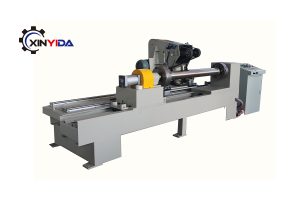Tube polishing machines are a critical process in various industries, including manufacturing, automotive, and aerospace, where smooth and aesthetically pleasing surfaces are essential. This process not only enhances the visual appeal of tubes but also improves their functional performance by removing surface imperfections and contaminants. In this article, we’ll delve into the basic principles of tube polishing, the specifics of what is removed during the process, the typical polishing steps involved, and discuss some of the best tube polishers available in the market.
Basic Principles of Tube Polishing machine
The fundamental principle of tube polishing machine involves the abrasion of the tube’s surface to achieve a smoother finish. This process typically uses polishing machines equipped with abrasive materials or compounds. The primary goal is to reduce surface roughness and remove any oxidation, scratches, or contaminants that can affect the tube’s performance or appearance.
The polishing process relies on controlled mechanical abrasion, where the abrasive material is applied to the tube’s surface with a specific amount of pressure and speed. This controlled abrasion gradually wears down the high points on the surface, creating a smooth and even finish. The type of abrasive used, the polishing technique, and the machine’s settings all play a crucial role in determining the quality of the final finish.
What is Removed During the Polishing Process?
During tube polishing machine, several types of surface imperfections and contaminants are removed, including:
Oxidation: Tubes, especially those made from metals, can develop a layer of oxidation over time. Polishing removes this oxidation layer, restoring the tube’s original luster.
Scratches and Dents: Polishing helps to eliminate minor scratches and dents on the tube’s surface, which can be caused by handling or manufacturing processes.
Surface Contaminants: Dirt, grease, and other contaminants that may have adhered to the tube’s surface during production or handling are also removed during polishing.
Surface Irregularities: Any inconsistencies in the surface, such as uneven spots or rough patches, are smoothed out, resulting in a uniform finish.
Polishing Steps of a Tube Polisher
The tube polishing machine process typically involves several key steps:
Preparation: Before polishing, it’s crucial to prepare the tube by cleaning it thoroughly. Any debris or contaminants should be removed to avoid scratching the surface during polishing.
Grinding: For heavily damaged or rough tubes, grinding is often the first step. This involves using a coarse abrasive to remove large imperfections and bring the surface closer to a smooth finish.
Polishing: Once the grinding is complete, finer abrasives are used in the polishing step. This involves applying polishing compounds or abrasive pads to the tube’s surface to further smooth out the finish and achieve the desired level of gloss.
Buffing: The final step in the polishing process is buffing. This step uses a soft cloth or buffing wheel along with a buffing compound to achieve a high shine and further smooth the surface.
Inspection: After polishing and buffing, the tube is inspected for any remaining imperfections. If necessary, additional polishing or buffing may be performed to address any issues.
The Best Tube Polisher
Choosing the best tube polisher depends on various factors, including the type of material being polished, the desired finish, and the scale of the operation. Here are some top-rated tube polishers known for their efficiency and effectiveness:
Xinyida Tube Polishers: Xinyida’s tube polishers are known for their durability and precision. Designed for both small-scale and industrial applications, they offer adjustable speeds and a range of abrasive options to suit different polishing needs.
Welcome to contact us to get the best price quote for Tube polishing machine!

